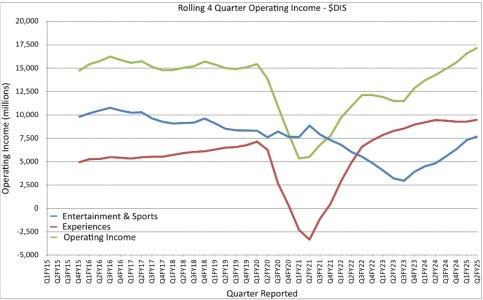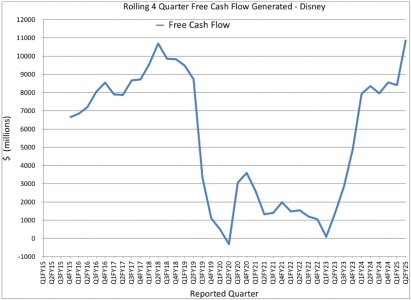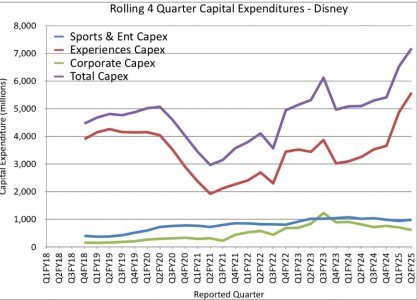Iger should have offload ABC-TV network first thing 2 1/2 years ago when he took back over from Chapek. Back then, we might have had something worth selling.
Nowadays, not so much.
https://www.wsj.com/articles/trump-tariffs-tv-ad-sales-63e6b670?mod=hp_lead_pos10
Tariffs Are Crashing TV’s Annual ‘Upfront’ Ad-Sales Party
Analysts expect economic uncertainty to loom large over a softer television ad-buying season
By
Suzanne Vranica and
Megan Graham
May 11, 2025 - 10:00 pm EDT
Television’s glitzy advertising-sales extravaganza is kicking into high gear this week, with media companies wooing brands to spend billions on their TV networks and streaming platforms.
But there is a plot twist. As the waitstaff prepare to serve signature cocktails and enough canapés to feed a small nation, tariffs have arrived as an unwelcome party crasher.
TV’s annual “upfront” selling season, when brands begin to commit ad dollars for the coming year, is unfolding against the backdrop of President Trump’s trade war. Questions about tariffs and their potential impact on consumer-spending plans and companies’ marketing budgets threaten to pour cold water on advertising demand, ad buyers and analysts said.
Consumer confidence has plunged to
its lowest point since October 2011, thanks in part to worries about tariffs. Sales have slowed across
restaurants and consumer-product companies. And some companies are pulling
their financial forecasts.
This year’s upfront market “will be especially challenging, given all the uncertainty over tariffs,” said media analyst Michael Nathanson. A growing supply of ad inventory, thanks to the proliferation of streaming options, also lessens the urgency to buy now, he said.
Financial concerns will get short shrift on stage, as media conglomerates including
Comcast’s NBCUniversal, Fox,
Warner Bros. Discovery and
Disney make their pitches to ad executives in New York City over the coming days. Newer tech entrants such as
Netflix,
Amazon.com and
Alphabet’s YouTube will also be vying for ad dollars, leaning heavily on star power with appearances expected from the likes of Lady Gaga and MrBeast.
Economic worries are already causing some brands to pare back their overall ad spending, and that is expected to play out in TV ad demand as well, according to ad executives.
One consumer-product company is planning to cut its overall ad spending by 7% this year, while a financial-services company has slashed its ad budget by about 15%, according to people close to the companies.
“I don’t think it’s going to be a strong upfront, by any stretch of the imagination,” said David Campanelli, president of global investment at media agency Horizon Media.
Even if tariffs are more moderate, Emarketer predicts advanced TV ad spending—including on streaming platforms—could fall 20.5% this year to $13.9 billion.
The one bright spot in this week’s festivities: sports.
Splintering audiences for most TV programming have made sports an essential buy for marketers that need to reach large, live audiences. TV networks, streamers and digital companies will be hyping their professional-sports content, particularly the National Football League.
NBCUniversal will use its upfront presentation Monday to also highlight next year’s Winter Olympics and National Basketball Association All-Star Weekend, following the company’s
recent deal to carry NBA games.
Sports content is expected to help some TV networks make up for a lot of the big ad cuts on the entertainment-programming side, ad buyers said.
Some media companies remained upbeat during recent earnings calls with investors. Disney said Wednesday that it continues to see robust demand for advertising going into the upfront season. And Netflix said last month that it isn’t currently seeing any signs of softness in the ad market.
Warner Bros. Discovery executives, however, acknowledged Thursday that upfront conversations are “probably going to go a little slower.”
Analysts and ad buyers said it is tough to forecast how deeply tariffs will affect overall ad spending because the levies keep shifting.
Still, TV could be particularly vulnerable because some of its biggest customers, such as pharmaceutical makers, automakers, retailers and consumer package-goods makers, are likely to be among the industries taking direct hits.
The economic headwinds are just the latest problem facing the TV business, with cord-cutting causing viewership to plunge and pushing advertisers to find new places to pitch their products and services.
Media companies have attempted to offset the deterioration by turning to ad-supported streaming, but that strategy hasn’t fully materialized. Many marketers
redirected portions of their TV budgets to digital and social platforms such as YouTube and TikTok instead.
“Owners of TV networks and streaming services combined can’t grow fast enough to make up for the money leaving TV,” said Brian Wieser, an industry analyst.
Excluding political advertising, marketers are expected to spend about $61 billion across traditional and digital television in the U.S. this year, down from about $64 billion in 2019, according to Wieser.
Chocolate giant Hershey, the maker of Kit Kat and Reese’s Peanut Butter Cups, is planning to shift roughly 15% of its cable-TV ad spending, largely to YouTube and
Amazon Prime.
Amazon is a draw because the e-commerce giant is better able to prove that ads lead to sales, said Vinny Rinaldi, Hershey’s vice president of media and marketing technology. Meanwhile, YouTube has grown into a streaming behemoth. Some 12% of the time U.S. audiences spent in front of TV screens in March was on YouTube’s TV app or watching YouTube on their smart TV’s internet browser,
Nielsen data shows.
“We are moving to the places where consumers are spending their time,” Rinaldi said.
Write to Suzanne Vranica at
Suzanne.Vranica@wsj.com and Megan Graham at
megan.graham@wsj.com



